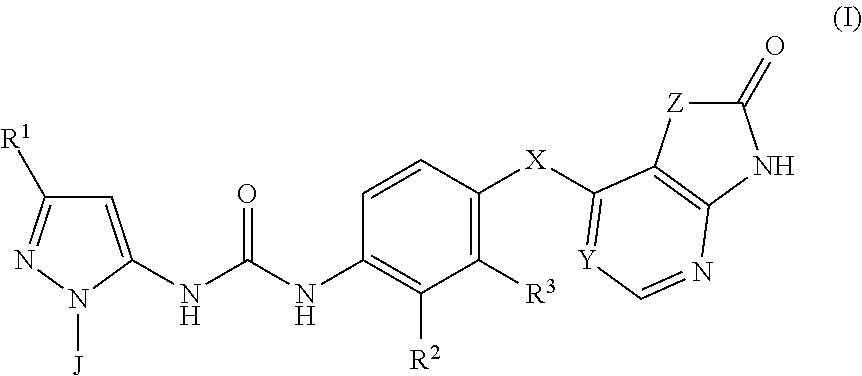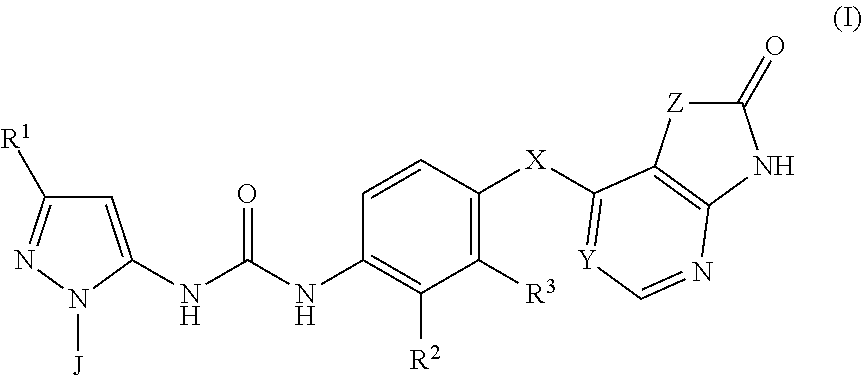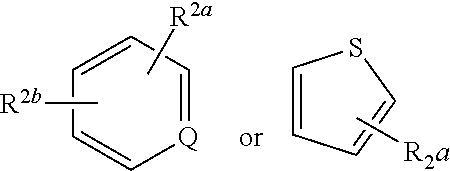Respiratory formulations and compounds for use therein
a technology of respiratory system and formulation, which is applied in the field of respiratory system formulation and compound for use therein, can solve the problems of patients' death, the phosphorylation of p38 mapks or jnks is affected, and the compound cannot be used in the field of respiratory system and compound for use, so as to reduce the risk of unwanted side effects, reduce the risk of side effects, and the effect of high affinity for the target receptor
- Summary
- Abstract
- Description
- Claims
- Application Information
AI Technical Summary
Benefits of technology
Problems solved by technology
Method used
Image
Examples
example 10
1-(3-(tert-Butyl)-1-(4-methoxyphenyl)-1H-pyrazol-5-yl)-3-(4-(1-methyl-2-oxo-2,3-dihydro-1H-imidazo[4,5-b]pyridin-7-yl)oxy)naphthalen-1-yl)urea
[0342]
[0343]To a solution of CDI (500 mg, 3.00 mmol) in dry DCM (6.0 mL) at RT was added Intermediate A2 (760 mg, 3.1 mmol) and the reaction mixture kept at RT for 4 hr. An aliquot of the resulting solution (0.70 mL, 0.40 mmol) was added to a suspension of Intermediate B2 (60 mg, 20 μmol) in dry THF (1.5 mL) and the reaction mixture was maintained at RT for 16 hr and was then quenched with MeOH (1.0 mL). After a further 5 min at RT the mixture was evaporated in vacuo and the residue was purified by flash column chromatography (SiO2, 12 g, EtOAc in isohexane, 0-100%, gradient elution) to afford the title compound, Example 10 as a pale brown solid (99 mg, 86%); Rt 2.16 min (method 2); m / z 578 (M+H)+, (ES+); 1H NMR (400 MHz, DMSO-d6) δ: 1.28 (9H, s), 3.53 (3H, s), 3.83 (3H, s), 6.29 (1H, d), 6.38 (1H, s), 7.12 (2H, d), 7.25 (1H, d), 7.48 (2H, d),...
example 11
1-(3-(tert-Butyl)-1-(4-methoxyphenyl)-1H-pyrazol-5-yl)-3-(4-(1-ethyl-2-oxo-2,3-dihydro-1H-imidazo[4,5-b]pyridin-7-yl)oxy)naphthalen-1-yl)urea
[0344]
[0345]To a solution of CDI (140 mg, 0.84 mmol) in dry DCM (1.0 mL) at RT was added Intermediate A2 (210 mg, 0.84 mmol) and the reaction mixture maintained at RT for 2 hr. An aliquot of the resulting solution (0.90 mL, 0.70 mmol) was added dropwise to a solution of Intermediate B3 (100 mg, 0.31 mmol) in dry THF (2.0 mL) and the reaction mixture was kept at RT for 3 days and was then partitioned between DCM (5.0 mL) and sat aq NaHCO3 (5.0 mL). The organic layer was separated and dried and was treated with activated charcoal and evaporated in vacuo. The residue was purified by flash column chromatography (SiO2, 12 g, MeOH in DCM, 0-5%, gradient elution) to afford the title compound, Example 11 as a pale brown solid (112 mg, 58%); Rt 2.24 min (Method 2); m / z 592 (M+H)+, (ES+); 1H NMR (400 MHz, DMSO-d6) δ: 1.28 (9H, s), 1.32 (3H, t), 3.84 (3H,...
example 12
1-(3-(tert-Butyl)-1-(4-methoxyphenyl)-1H-pyrazol-5-yl)-3-(4-(1-isopropyl-2-oxo-2,3-dihydro-1H-imidazo[4,5-b]pyridin-7-yl)oxy)naphthalen-1-yl)urea
[0346]
[0347]To a solution of CDI (130 mg, 0.81 mmol) in dry DCM (1.0 mL) at RT was added Intermediate A2 (0.20 mg, 0.81 mmol) and the reaction mixture kept at RT for 2 hr. An aliquot of the resulting solution (0.90 mL, 0.70 mmol) was added dropwise to a solution of Intermediate B4 (100 mg, 0.30 mmol) in dry THF (1.0 mL) and the reaction mixture was maintained at RT and after 1 hr was treated with an additional portion of the preformed CDI adduct (25 μL, 20 μmol). After 3 days at RT the resulting mixture was partitioned between DCM (5.0 mL) and sat aq. NaHCO3 (5.0 mL). The organic layer was separated and dried and then treated with activated charcoal and evaporated in vacuo. The residue was purified by flash column chromatography (SiO2, 12 g, MeOH in DCM, 0-5%, gradient elution) to afford the title compound, Example 12 as a pale brown solid ...
PUM
| Property | Measurement | Unit |
|---|---|---|
| temperature | aaaaa | aaaaa |
| temperature | aaaaa | aaaaa |
| temperature | aaaaa | aaaaa |
Abstract
Description
Claims
Application Information
 Login to View More
Login to View More - R&D
- Intellectual Property
- Life Sciences
- Materials
- Tech Scout
- Unparalleled Data Quality
- Higher Quality Content
- 60% Fewer Hallucinations
Browse by: Latest US Patents, China's latest patents, Technical Efficacy Thesaurus, Application Domain, Technology Topic, Popular Technical Reports.
© 2025 PatSnap. All rights reserved.Legal|Privacy policy|Modern Slavery Act Transparency Statement|Sitemap|About US| Contact US: help@patsnap.com



